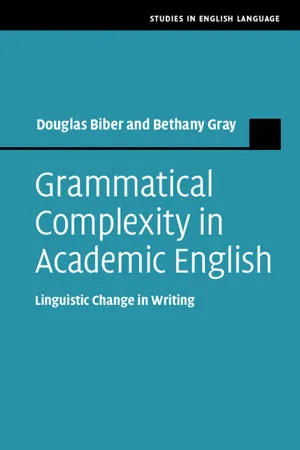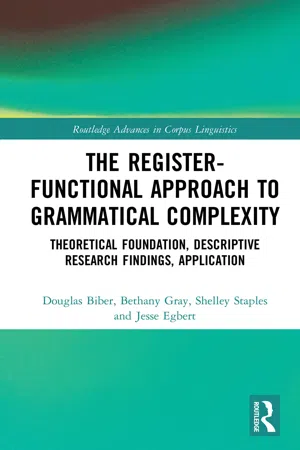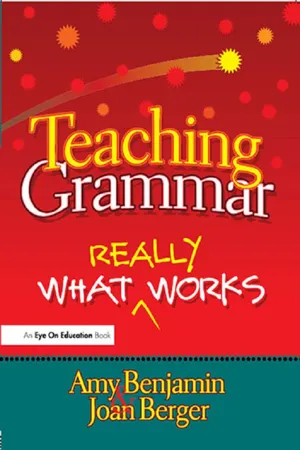Languages & Linguistics
Appositive Phrase
An appositive phrase is a noun phrase that renames or explains another noun in a sentence. It provides additional information about the noun it follows and is set off by commas. For example, in the sentence "My friend, a talented artist, painted a beautiful mural," the appositive phrase "a talented artist" provides more detail about the noun "friend."
Written by Perlego with AI-assistance
Related key terms
1 of 5
8 Key excerpts on "Appositive Phrase"
- eBook - PDF
English in Transition
Corpus-based Studies in Linguistic Variation and Genre Styles
- Matti Rissanen, Merja Kytö, Kirsi Heikkonen, Matti Rissanen, Merja Kytö, Kirsi Heikkonen(Authors)
- 2011(Publication Date)
- De Gruyter Mouton(Publisher)
In nonre-strictive apposition, the appositives are in separate information units, pro-viding relatively independent information. The first appositive normally acts as the defined expression and the second has a defining role. In Pres-ent-day English, the defining role of the second appositive is reflected by the fact that it is marked as parenthetic by punctuation or intonation. Quirk et al. (1985: §§17.74-17.87) also classify appositions into various semantic classes ranging from different degrees of equivalence (appella-tion, identification, designation and reformulation) to attribution, and in-clusion (exemplification and particularization). In recent discussions of apposition, both Acuna (1996) and Meyer (1987: 101 and 1992: 3) argue that all earlier definitions of apposition, taken individually, are inadequate or incomplete. Most definitions are too narrow, whereas some admit as appositions constructions which should not be included (e.g., Curme's category of appositive adjectives, see p. 123 above). Meyer points out that the difficulties which linguists and grammarians have had in defining apposition are caused by the fact that they regard it as primarily a syntactic relation. Meyer argues that apposi-tion is not merely a syntactic relation; it must also be viewed as a seman-tic and pragmatic relation, and should be defined in terms of those char-acteristics which distinguish it from other grammatical relations — com- Expository apposition 125 plementation, modification, parataxis, peripheral elements, and coordina-tion. In Apposition in contemporary English , Meyer (1992) provides a comprehensive analysis of the syntactic, semantic and pragmatic charac-teristics of apposition based on his study of appositions in three computer corpora of English. 4 He views apposition as a grammatical relation hav-ing various realizations, which are described in Table 1, adopted from Meyer (1992: 6). - eBook - PDF
Grammatical Complexity in Academic English
Linguistic Change in Writing
- Douglas Biber, Bethany Gray(Authors)
- 2016(Publication Date)
- Cambridge University Press(Publisher)
For example: In about two months after it had acquired this additional head, a fragment separated from the tail (the most usual place of separation) and was in progress towards its entire reproduction when it was acci- dently lost. . . the former is composed of sporules, empty tubes (the mycelium ), and tubes filled with sporules 204 Functional extension of phrasal grammatical features Despite this variation in form and meaning, appositive noun phrases throughout the nineteenth century retained the primary meaning rela- tionship of being directly co-referential with the head noun. Thus, in the examples mentioned earlier, Mr. William Young is Botanist to their Britannick Majesties; the patient was a young girl about 13 years of age; the root is the only efficient part; tinca (herpes) tonsurans is ringworm of the scalp, and so on. This directly co-referential meaning relationship continues to be the primary one expressed by appositive noun phrases in present-day news- paper prose. However, in twentieth century academic research writing, appositive noun phrases began to be used to express information having a wider range of implicit meaning relationships to the head noun. These noun phrases can be quite long and complex, and so they are usually contained in parentheses, rather than separated by commas. Often, an appositive noun phrase is used to introduce an acronym, or to itemize the members of a group, as in: We present the results of the International Meta-analysis of Mortality Impact of Systemic Sclerosis (IMMISS ). . . In four cohorts (Athens, Keio, Mayo, and Florence ), investigators stated that. . . However, in many other cases, the meaning relationship is more special- ized in academic research writing. - eBook - ePub
The Register-Functional Approach to Grammatical Complexity
Theoretical Foundation, Descriptive Research Findings, Application
- Douglas Biber, Bethany Gray, Shelley Staples, Jesse Egbert(Authors)
- 2021(Publication Date)
- Routledge(Publisher)
However, in many other cases, the meaning relationship is more specialized in academic research writing. For example, consider the following sentence, where the appositive noun phrase is not strictly co-referential with the head noun:- Comparison of these scores to the studies in our meta-analysis reveals that they are all of moderate quality ( scores of 2 to 4 on a scale of 0 to 5).
- Numerous variables were measured, including case status, sex, race, date of enrollment (date of first visit to the cohort with the pertinent diagnosis ), age at first visit, …
In this example, the head noun identifies a variable that was used in a study, and the appositive noun phrase is used to specify methodological information, documenting how that variable (‘date of enrollment’) was measured in the study. The meaning could have been made more explicit through the use of clausal structures, something like:- *For the purposes of this study, we operationally defined the variable ‘date of enrollment’ as the date when the subject made the first visit to the cohort with the pertinent diagnosis.
Appositive noun phrases are commonly used for such functions in modern scientific writing. The following example illustrates the dense use of appositive noun phrases in a science research article, often with appositives embedded in other appositives:- Timing of peak growth coincides with the observed peak growth of our wild parr; a period when their growth effectiveness(assimilation minus BMR ) was high (fig. 1d) and the period when their natural food was particularly abundant .
The highest level appositive in this example expresses the classical co-referential meaning: the observed peak growth of our wild parr is a period when their growth effectiveness was high. However, the embedded appositive noun phrase (assimilation minus BMR - eBook - PDF
- Jacek Fisiak(Author)
- 2011(Publication Date)
- De Gruyter Mouton(Publisher)
Middle English nonrestrictive expository apposition with an explicit marker Saara Nevanlinna—Päivi Pahta 1. Introductory 1 The term apposition goes back to Latin appositus 'set beside'. For the medieval scholars language was Classical Latin, among whose features they discovered the differences between concord, government and apposi-tion (Bloomfield 1965). Apposition contains two units, the second of which is expected to give additional information about the first unit. Charles F. Meyer points out in the preface to his monograph Apposi-tion in contemporary English (1992) that though apposition has been widely discussed in scholarly grammars, especially in the twentieth cen-tury, it still remains a poorly understood category, and there has been much disagreement as to how it should be defined (see Meyer 1992: 1 — 5; Pahta-Nevanlinna, forthcoming a). Apposition has traditionally been defined in terms of its syntactic characteristics, whereas Meyer (1992: xiii) argues that apposition is a grammatical relation (like complementation and modification) realized by constructions having particular syntactic, semantic and pragmatic characteristics. In the early twentieth century, mainly juxtaposed noun phrases were regarded as appositional, or at least one of the appositives had to be a noun phrase (cf. Curme 1931: 88 or Fries 1952: 187). In some more recent definitions a variety of non-nominal phrases are also recognized as appo-sitional: the units in apposition can be adjective phrases, prepositional phrases, verb phrases, predicative phrases, or adverbial phrases, as well as clauses or sentences. Appositions can also have a variety of syntactic functions, appositional constructions appearing in the function of sub-ject, object, complement, adverbial, or verb (see Meyer 1992: 31—35). In most traditional definitions the units in apposition are regarded as coreferential (cf. Leech 1981: 156), but recent research has expanded the notion of apposition also in this respect. - eBook - PDF
Navigating English Grammar
A Guide to Analyzing Real Language
- Anne Lobeck, Kristin Denham(Authors)
- 2013(Publication Date)
- Wiley-Blackwell(Publisher)
Appositives are nonrestrictive, and are set off by commas in writing and by comma intonation in speech. They don’t restrict the reference of the noun (or NP) they follow, but rather add extra information and sometimes even “rename” that NP. Hugh, my husband, met me at the airport. The bird, a seagull, hopped along the beach. The President, Commander in Chief, must make difficult decisions. Like the other modifiers we’ve discussed in this chapter, appositive NPs allow us to pack more information into a single clause, rather than stating this information in two separate clauses. The bird hopped along the beach. It was a seagull. or coordinating those clauses The bird hopped along the beach and it was a seagull. we can combine both using an appositive NP. The bird, a seagull, hopped along the beach. Summary In this chapter we have reviewed what we have learned about complementation and modification, including some of the important differences between these two grammatical functions. We have investigated how, in addition to subordination and coordination, which we learned about in Chapter 10, we can use movable mod- ifiers of different categories to combine clauses into larger, more complex units. We 266 More on Complementation and Modification introduced the concept of a layered VP to account for the evidence that movable modifiers and complements occur in different positions; the verb and its comple- ment are dominated by one layer, and modifiers by another, higher layer. We also explored relative clauses as another way to combine clauses and create more com- plex sentences. Restrictive relative clauses can be tensed or infinitival, limiting the reference of the noun they modify. Certain tensed restrictive relative clauses can also be reduced, occurring without a relative pronoun and auxiliary verb. Nonrestrictive relative clauses, which are typically tensed, do not limit the refer- ence of a noun, and can’t be reduced. - eBook - ePub
Teaching Grammar
What Really Works
- Amy Benjamin, Joan Berger(Authors)
- 2014(Publication Date)
- Routledge(Publisher)
nonessential —to them.Pair by pair, the students add their noun phrases to the sentences on the board, giving everyone a chance to hear the repeated use of Appositive Phrases and observe the need to insert commas. Hermania tells the second pair of students that there is a name for the phrase they are writing, an “Appositive Phrase.”As more students come forward, she can use that terminology repeatedly and ask the students to use their “writers’ language”: “Tell me which words make up your Appositive Phrase and what job they do in the sentence,” she urges. They answer with words like, “My appositive is a wise man, and it gives more information about the Giver in the sentence, He needs advice from the Giver, a wise man.”Hermania has intentionally distributed five extra phrases that do not fit The Giver sentences and asks the remaining pairs of students to think of a sentence where their noun phrases will fit in. James waves his hand with an idea and calls out, “My sign has the words a great singer. I could use them in the sentence Beyonce, a great singer, has won three Grammy awards.”“That’s perfect, James. Does everyone see how James uses the appositive a great singer to add more information about Beyonce?” The other students create sentences in which they can use their noun phrases, too. By the time the class ends, ten sentences appear on the board. You’ll notice how Hermania gradually shifts the responsibility to her students, having them create their own sentences after she introduces and discusses model sentences.As homework, Hermania asks her students to choose a TV program or movie and write three sentences about its characters. In each sentence they must use an appositive as they have done in class. She sends them out with two sample sentences as models for theirs:Ms. Rodriguez, my English teacher - eBook - PDF
English Language, The
From Sound to Sense
- Gerald P. Delahunty, James J. Garvey(Authors)
- 2010(Publication Date)
- Parlor Press, LLC(Publisher)
In written English, appositives are set off by commas— The President of the US , who is in his 7 th year in office, has only one more year to serve . In cases like this, the writer assumes that the reader will know who the President of the US is and so does not need the appositive information to identify him. Nonetheless, the writer adds the information that the President is in his 7 th year in office as a sort of secondary predicate in addition to the primary one, namely, that he has only one more year to serve. In spoken English, appositives are set off from the remainder of the sentence by brief pauses (hence the commas) and a drop in pitch. From a writer’s or speaker’s point of view, it is essential to decide whether the audience does or does not need the modifier to identify the referent of the phrase. THE ADVERB PHRASE ( ADVP ) The following are examples of adverb phrases : (4) a. adamantly (adverb alone) b. quite reluctantly (adverb modified by intensifier) c. extremely clumsily (adverb modified by degree adverb) From a functional point of view, each AdvP must contain a head, which must be an adverb; this adverb may be modified by an intensifier , as in (4b), or by a degree adverb , as in (4c). Examples of these are listed in Table 1. Delahunty and Garvey 280 very extraordinarily quite reasonably rather particularly too extremely more/most terrifically only somewhat table 1: typical intensifiers and degree adverbs The following formula encapsulates the functional properties of AdvPs: (5) (Modifier) + Head [In formulae like this, parentheses indicate optional elements.] The structures associated with (4a), (4b), and (4c) may be represented by the following trees: (6)a. AdvP (6)b. AdvP Adv Int Adv adamantly quite reluctantly (6)c. - eBook - PDF
Language in Time and Space
A Festschrift for Werner Winter on the Occasion of his 80th Birthday
- Brigitte L.M. Bauer, Georges-Jean Pinault, Brigitte L.M. Bauer, Georges-Jean Pinault, Brigitte L. M. Bauer, Georges-Jean Pinault(Authors)
- 2011(Publication Date)
- De Gruyter Mouton(Publisher)
Apposition and word-order typology in Indo-European Olav Hackstein 1. Within Indo-European syntax, the phenomenon of apposition has al-ways been a rather marginal issue. Usually apposition is treated under the heading 'attribute' and subsumed thereunder as a special case of an attri-bute, namely a substantive attribute. In the standard and cross-linguisti-cally most frequent case of apposition, an appositional noun is juxtaposed to the noun it classifies or identifies, e. g. King Richard. ' It seems that apposition has not been regarded so much as a grammati-cal entity because of the absence of morphological and syntactical guide-lines. Since both the apposition and the concomitant noun occur in the same case form, there is no formally marked dependency relationship be-tween the two nouns. And from a syntactic point of view there seem to be practically no positional constraints. Examples may be adduced from English or other modern languages in which certain appositions may either precede or follow the noun they classify, e.g. Philip, my best friend or my best friend, Philip. All in all, apposition seems to be a phenomenon that is unexpectedly difficult to describe formally and in terms of strict rules. This impression is implicit in many definitions of apposition, which then may easily create the impression that the position of the apposition is not governed by rules and so is arbitrary, cf. for instance, Bussmann (1996: 30): Optional con-stituent of a noun phrase which agrees syntactically and usually referen-tially with the nominal head. Appositions can be either closely or loosely connected with the nominal head, and preposed or postposed: Aunt Nelly, Mr Smith, President Jones; Philipp, my best friend. (...). It is therefore perhaps not entirely fortuitous that current research has often concen-trated on the functional semantics of apposition 2 , giving little or no atten-tion to word order 3 .
Index pages curate the most relevant extracts from our library of academic textbooks. They’ve been created using an in-house natural language model (NLM), each adding context and meaning to key research topics.







